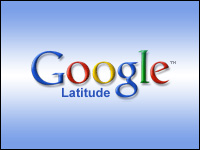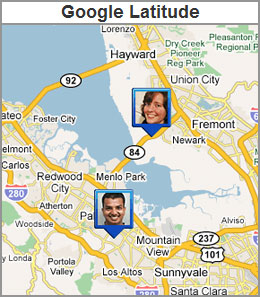
 Until now, it seemed the only thing Google didn’t know about you was where you were. Now that its mission to capture and categorize all information online is well in hand, Google has taken steps to add that missing piece with the introduction of Latitude. Built into Google Maps for Mobile and iGoogle, this location-sharing feature tracks users’ comings and goings.
Until now, it seemed the only thing Google didn’t know about you was where you were. Now that its mission to capture and categorize all information online is well in hand, Google has taken steps to add that missing piece with the introduction of Latitude. Built into Google Maps for Mobile and iGoogle, this location-sharing feature tracks users’ comings and goings.
After they sign up for the opt-in service and activate the friend-sharing feature, Google follows users by means of signals from nearby cell towers. The service then superimposes their profile pictures or icons on a map that is accessible to friends via a computer or mobile device.
There are two ways to use Latitude right now: downloading Google Maps for mobile with Latitude to a smartphone’s mobile browser; and adding the Latitude gadget to a iGoogle homepage. To access the service from a computer, the user has to install Google Gears or use Google Chrome.
Latitude builds on functionality Google introduced in November 2007, when it location-enabled Google Maps for mobile phones, wrote Charles Mendis, software engineer with the Google mobile team, in Latitude’s official blog.
“Using My Location, millions of you have been able to easily find yourselves on a map at the touch of a button. But what about finding other people? Lots of you have been requesting to see where your friends are on a map, too.”
What It Can Do
The service lets users call, text, email or IM a friend by clicking on the photo. Depending on the privacy controls selected, driving directions to a friend’s current location may also be provided. The service lets users dole out information on a user-by-user basis. One friend may be approved to get an exact location; others may just be given the name of the city or town.
Latitude can automatically detect and update a user’s location on most smartphones — but there isn’t a fixed or set update frequency. That is determined by factors such as a phone’s battery life and, of course, how recently a location has changed.
Google points out this caveat: Continuous location sharing uses a lot of data. It recommends that users opt for an unlimited data plan before using this feature.
Latitude is available in 27 countries and 42 languages. Right now, it supports several smartphone platforms including Android, Blackberry, Symbian S60 and Windows Mobile. Google intends to add Latitude to Google Mobile App for the iPhone “soon.”
Despite Google’s highlighting of Latitude’s opt-in controls, the privacy implications are arguably creepy, at least to people who have not acclimated themselves to having every aspect of their lives plastered online. There is a big online constituency, though, who will relish the real-time, 360-degree openness that Web 2.0 delivers. It is these people Google — and marketers — want to attract.
One-Off vs. Suite Offering
To truly harness the application’s potential, Google will need to work with other service providers to integrate it into larger social networks, making it a checkbox feature, Dan Shust, director of emerging media at Resource Interactive, told TechNewsWorld.
“We have tested numerous Web 2.0 applications here and have found that one-off offerings like this really should be part of a larger service … to be widely adopted,” he said. “Standalone solutions are just too hard to get off the ground — and, consequently, people don’t use them.”
Similar services, such as Brightkite and Loopt, are faced with the same issues, said Shust. “All of them have tremendous potential to help you see what your friends are up to, stage impromptu meet-ups, crowdsource, etc. But, they also all have a similar problem. … They make me manage another — always smaller — set of friends. We won’t realize the true power of location awareness until this functionality is built directly into the major social networks.”
Sticky and Getting Stickier
Assuming Latitude remains just a fun, one-off feature, it will still meet another of the company’s goals: making Google and its wide range of tools as sticky as possible.Commercial artist John T. Unger, for instance, is familiar with the business value-add that Google’s services can deliver because he uses Google Maps to illustrate all the locations that have purchased his handmade firebowls.
The map “informs me where my sales are best and where to focus my marketing,” Unger told TechNewsWorld. I knew I had a lot of West Coast sales, but had no idea that sales were so good on the East Coast before the map. It also helps prospective wholesale buyers see that there is a market in their area or if they have an exclusive in their area.”
Unger plans to use Latitude as sort of a “presence” service for his clients once it becomes available for the iPhone. “The more up-front and transparent I am with my clients, the smoother it goes. It would be great for them to see where I was — if I was across town or away from my office — so they could plan accordingly.”




















































